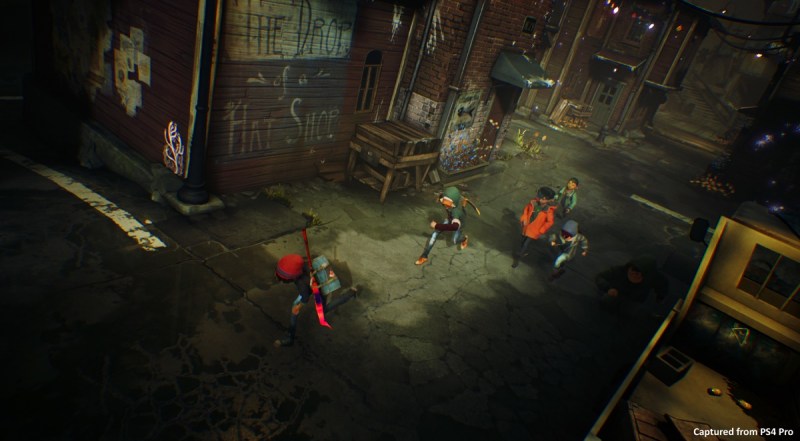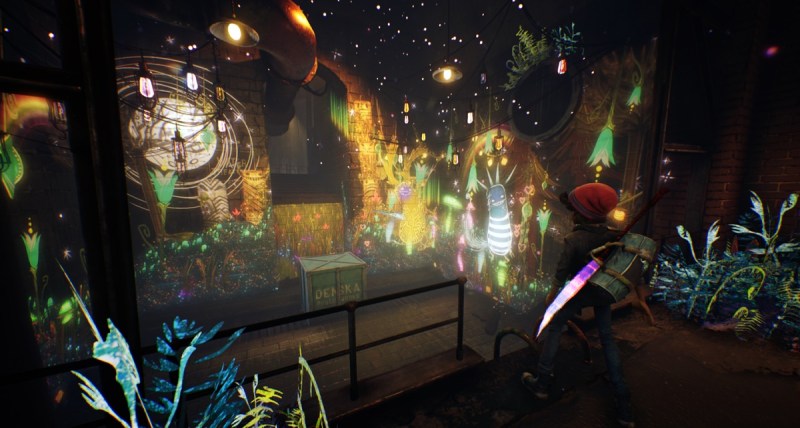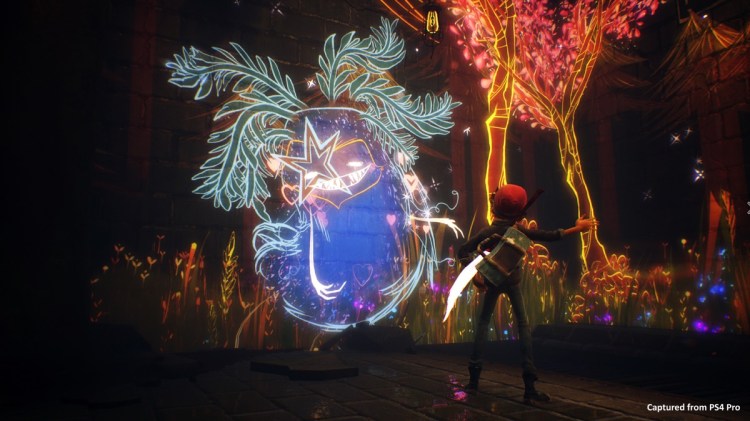
Above: The bullies are after Ash in Concrete Genie.
GamesBeat: Was there ever a kind of graffiti angle to it? It doesn’t seem quite in that style.
Robillard: One of the things that was amazing about developing the story of the world as well was that — we were discussing this as a team. My hometown in Bristol, in England, has a quite celebrated history of urban illustration and street artwork. Communities embrace it there as a way of bringing color and life to some of the more run-down parts of town. But interesting enough, it turned out that Jing Li, our game designer, had a very similar idea from her hometown as well. They would particularly use kids’ artwork and put it on walls and other parts of town to bring light and color into their spaces as well.
We suddenly had this shared experience that we wanted to bring into the game. That was where that came from. But Jeff has a great way of talking about our take on that as well.
Sangalli: There are certain graffiti artists that have a unique style. It’s their own personal voice that they’re creating. It usually has a strong look, and they’re developing the medium of graffiti artwork. That’s why urban illustration comes to mind, because it’s very image-based in its subject matter. I think we’re trying to get our own personal voice across too, through Ash, that this is his world he’s creating, in a very similar way.
GamesBeat: You had a small team working for four and a half years. Did you ever have big discussions about what the scope of this should be, how big it should be, how big the town should be? I didn’t feel like it was a huge experience. It feels fairly contained. The $30 price suggests to me that it’s not going to be a 50-hour game. But how did you scope this?
Robillard: We pretty much did exactly what you just described. We had various moments where we did discuss the scope, but it wasn’t in terms of a resource footprint. It was more from what was right for the game and the story of these kids, presenting a world that felt right for that. There were times when we had a much bigger version of the city, and it just felt out of scale. It wasn’t matching the kind of lens of nostalgia that we have on this game, looking back to when you were a kid and how the size of these spaces felt. Building a space above the ground level, in the rooftops, that felt like a safe space for Ash, a fun place for him to explore. Getting and tuning that just right took a lot of iterations on the world.
Sangalli: When you make the city — we did some tests with a very big city, but the city becomes a daunting character. It looks like a 14-year-old wouldn’t be allowed to be out at night in that area. It overpowers the story of a group of kids that lives in a neighborhood.
Robillard: We always wanted to make sure that this idea of a hometown — that you believed his affection for it, the warmth he has for this place and wanting to return it to its former self. It’s much easier to look at the scale as a way to manifest that in the correct way.

Above: You bring the art in the walls to life, and create some of your own in Concrete Genie.
GamesBeat: What would have been the hardest part about getting this done?
Robillard: My God, so many things. I’m trying to think what’s the biggest thing I look back on, and I can’t believe we managed to do it. We might have different answers. I think the craziest things have been the living paint, the paint mechanics. Being able to do that anywhere and everywhere, and have it be persistent, and make sure that everyone’s version of this game really does look different, and then how that affects the AI of these creatures, these genies that you make as well. Being able to have variety there that’s driven through player choice has been super tricky to do with a small team. That’s the thing that I’ll probably look back on and think, “I can’t believe we did that.”
Sangalli: For me it’s the same. With the action-adventure genre, there are games that you can be inspired by, but making your paintings come to life, there’s really nothing to draw upon in the way that we were presenting it. And then trying to make sure that they were compelling enough just to our team, where we felt like we weren’t taking an easy way out, is what took all the time.
We had a massive celebration when we got a genie just to make a turn to a different wall. That was a huge technical undertaking, where it would traverse around a corner. I remember everyone was saying, “Yeah, we did it!” That meant that they could walk around the whole city and follow you. It was huge. That’s the kind of small wins that were big wins for us, that were super important.
Robillard: The other thing that was interesting, at some of those moments where we had these big hurdles to get past, we were able to interact with the execs here. The area that you just saw, when you come out of the elevator, the office to the left, that’s Connie Booth’s office. She’s the vice president of the studio. We sit right next to all of the execs who manage all of those other big games.
One of the things we’ve benefited from, we get to work with them and show them our work and have the kind of support and — what’s the word? Insight from them about helping us get where we want to go. That’s quite unique to PlayStation and first party. But they’re also the ones that will say, “I think you’re not quite living up to the dreams you had when you started out on this game.” Some of the iterations on the painting mechanics were driven through those types of conversations. When you have those moments here, though, they come with the additional time to get that. That’s quite a unique thing that we never take for granted, and that we’re super grateful for.
We’ve just been writing about this in the art-of book. There were these key moments where we would come to the review meetings with the execs, and the way that they interact with you support you through those moments, those difficult bits, it’s pretty special. We’re very lucky to have the amount of time that we’ve had.

Above: Magical art in Concrete Genie.
GamesBeat: I would think that a game like this could have required a huge art team. But you managed to do it with a very small team. How did that part come about?
Sangalli: I ask myself that question too. [laughs] I think it happened because we have a small team, but the people on the team are very versatile. They care very much about this project. It wasn’t an IP that was given to us. It was an IP that came, essentially, from the art department. We’ve all put a lot of ourselves into it, a lot of passion and love into it. Hopefully, that comes across.
Robillard: Jeff and I met working on a small team before we were here. The type of autonomy that you have, and the ownership, when you have a flat hierarchy and a small group of people working on something, it’s very special. You do feel more driven and passionate because it’s something where we share the vision in a small group.
Sangalli: You also have really great key senior members that mentor the younger people, so they’re ensured some kind of success. But they don’t overly critique them. The creativity that they have is not snuffed out. That’s always a balance, getting just the right amount of water so you don’t overwater them and they wilt. It’s just enough.
GamesBeat: I felt like you guys didn’t do any of the art. It was like I was doing it all.
Sangalli: [laughs] To be honest, we have that reaction when we see somebody — it’s been great on the tour. We see somebody painting in ways that we didn’t expect. “My gosh, that looks beautiful.” It’s still really enjoyable for me to see people paint. They are creating their own artwork.
Robillard: One of the things we’ve been talking about as well is we have a photo mode, as you’d expect in a game like this. But the twist for our photo mode is that when you’ve composed your shot, you can hit the square button and it will time-lapse replay all of the painted elements, one after the other, so you can take a clip of how you painted the scene. We can’t wait for people to use that and show how they’ve constructed their scenes.

